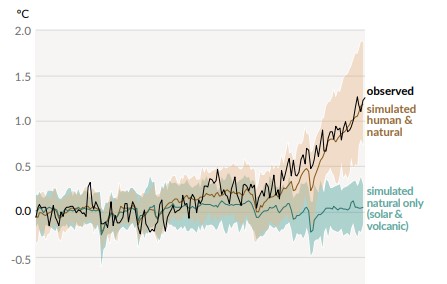The silver lining of IPCC AR-6: Climate-Ecology-Physical Perspective

An optimistic vision to IPCC AR 6 Physical Science Report
Yash Khanna
Earth has been under a strenuous condition in context to the utilization of natural resources, atmosphere and climate, land use, etc. It is quite imperative that the entire ecology of the Earth is under an unprecedented imbalance and is tending towards a state of irreversibility. Over the last couple of decades, the Earth has been exposed to an unprecedented temperature rise. In citation to the latest IPCC AR 6 report on the physical science perspective, there have been two major elongated phases of exorbitant warming which occurred 6500 years and 125000 years ago. In addition to this, last two centuries has experienced a rapid rise in exorbitant warming through the onset and expansion of the industrial revolution, thus, our climate is experiencing a similar scale of the warming. While the two historic phases occurred because of inter-glacial activities and orbital shift, the hypothesis of anthropogenic simulated warming over the current phase is proving out to be a real phenomenon. The diagram below shows how within the current time horizon of 21 century, the anthropogenic temperature effect is by far 1 degree higher than what the natural means would have had.

Speaking of percentages and numbers, it has been estimated that anthropogenic contribution to the post-1900 global warming has been 66% within the processes of the entire nature. Humans have thereby not only become a bane to the animal, marine, bird, forest and other living systems, but also towards their self-existence. The law of entropy is the most fundamental law of thermodynamic which has its impact on all-natural processes. Earth’s greatest irony is that the most advanced beings have managed to create an environment that has led to the most unethical implementation of the strongest law i.e., the law of entropy.

The decade perspective on the last decade of the 19th century (1850-1900) and the previous decade of 21 century (2010-2019), speaks a lot about the mismanagement of humans! The average global temperature has increased by a range of 1 degree Celsius. The respective concentration of Carbon dioxide, Methane and Nitrous oxide is on a record of at least 800000 years high. Observational increase in three major greenhouse gasses since 1750 (Advent of the industrial revolution) indicates 47% increase in carbon-dioxide levels, 156% in methane levels and 23% in Nitrous-oxide are exceeding or comparatively at pat with the previous natural glacial-interglacial natural transformation (cold to warm) over the past 800000 years, as indicated in the latest IPCC AR-6. It can be concurred that those human efforts to develop and bring efficient inventions have eventually made the entropy increase more efficient leading to the higher order of untraceable irreversibility, provided measures to reverse engineer the process are implemented. The decade perspective has intensified the gravity factor of ecological extremities, minimum Arctic Sea ice since 1850, warmest ocean level since last 11000 years, pH increase, fastest ten-year sea-level rise. Coming to land-based ecosystems the last decade has experienced the fastest rates of agricultural draught due to transpiration. Post-industrial revolution, the radiative forcing has almost tripled now, which indicates that Earth’s carbon trapping has tripled. Such phenomena call upon long-drawn conclaves, discussions, accusations, claims, suggestions. But apart from such front-end verbal events, what is often neglected is the back-end research initiatives that take place on a multi-dimensional and multi-sector spectrum. This is what defines the silver lining of climate change. Statistical and surrogate modeling have opened a domain of research wherein economy; energy, climate, land and demography can be merged to form an integrated modeling approach. The International Institute of Applied Systems Studies is the forefront research institute for climate change and has formulated the basis of defining development scenarios, which bring upon the eventuality of how our future might look like. Such scenarios are termed Shared Socioeconomic pathways are widely accepted databases that have merged the above-defined research domains to show how the emission trajectory would like in context to Earth’s carbon trapping (RCP – Representative Concentration Pathway) and the timeframe wherein negative /zero-emission state would be achieved or whether not!
There are five such scenarios. The rocky pathway /fossil future, the BAU / current level scenario with no further interventions. Considering the continuous improvement process in the national policy framework in the context of the energy sector, it is imperative that with technologies like solar PV, wind, fuel cells and CCS acting as bolster and catalyst, long term occurrence of these two pathways is unlikely. As we move upper the ladder of optimism the scenarios defined are SSP-2, also known as “Middle of the road pathway” (4.5 RCP) and SSP1, which is known as the “Sustainability pathway”. SSP1 further has two sub-conditions of 2.4 RCP and 1.9 RCP. SSP2 would keep the emissions constraint at current levels. When taken on a perspective of emission intensity to GDP, the world after mid-century can possibly turn into a growth saturation as the rapid interventions in developing Asia and the continuous growth in biomass research within Africa would like to bring the global emission to GDP intensity towards a saturating curve at a very likely trend post-mid-century could be a reducing trend. Considering the fact that nature does have its own elasticity, it is very likely that on a long-term horizon the natural process memory of Earth would definitely lead to a mechanism of self-healing that can correspond to the most optimistic SSP-1’s. Scientifically all-natural processes do have a period of transiency and if the elasticity limit is exceeded, the time of the transient phase in the reversal is steeper, which can make the ecological imbalances exorbitant. But again, by the concept of analogy, the steeper the reversal, the shorter would be the period of ecological imbalance. When evolution would be brought to perspective, species would unconsciously prepare for such a phase and thereby the ecological collateral damage can be controlled. What humans need to introspect upon is the reverse engineering support they need to give to nature to change the likely achievable SSP1 -2.4 to make SSP1-1.9 a reality!

Citation:
All figures are taken from IPCC_AR6_WGI Report
IPCC, 2021: Climate Change 2021: The Physical Science Basis. Contribution of Working Group I to the Sixth Assessment Report of the Intergovernmental Panel on Climate Change [Masson-Delmotte, V., P. Zhai, A. Pirani, S.L. Connors, C. Péan, S. Berger, N. Caud, Y. Chen, L. Goldfarb, M.I. Gomis, M. Huang, K. Leitzell, E. Lonnoy, J.B.R. Matthews, T.K. Maycock, T. Waterfield, O. Yelekçi, R. Yu, and B. Zhou (eds.)]. Cambridge University Press. In Press.
Disclaimer: The views presented in this article is of the author himself, this does not reflect the ideology of the organization. The views are personal and are for public address.

